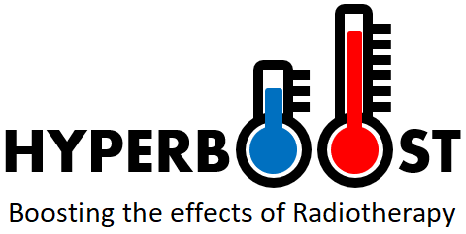About Us
Welcome to the website of our network Hyperthermia boosting the effect of Radiotherapy-Hyperboost (project 955625 funded by a European Horizon 2020 MSCA-Innovative training network grant).
Before you continue reading watch our video explaining Hyperboost from our recent consortium meeting in Winterthur, with special thanks to the team from KSA Aarau who made this possible!
| Optimisation of hyperthermia as an anti-cancer treatment Elevating the temperature in tumours to 40-44 °C – a process known as hyperthermia – is emerging as an attractive anti-cancer treatment that can be used to enhance effectiveness of radiotherapy or chemotherapy. Key objective of the EU-funded HYPERBOOST project is to further improve effectiveness and synergy of hyperthermia by identifying and implementing optimal temperature levels and optimal timing with other modalities in different tumour types. Researchers will investigate the mechanisms responsible for the therapeutic effect of hyperthermia via an interdisciplinary approach that combines biology, physics and oncology disciplines. The generated knowledge and practical tools will pave the way for personalised hyperthermia treatment with improved clinical results. |
Hyperthermia (HT), heating tumors to temperatures of 40-44°C, is an oncological treatment used in combination with radiotherapy (RT) and chemotherapy to enhance their efficacy. Clinical effectiveness of HT has been demonstrated in randomised studies and HT is currently applied for many clinical indications, like cervical cancer and recurrent breast cancer. Clinical results can be further improved as application of HT with well-controlled tumor temperatures and optimal timing and sequence realising full synergy of RT+HT is challenging. Optimal HT delivery requires accurate planning, moreover preclinical research has shown that many mechanisms are responsible for the therapeutic effect of HT, all presumably with a different temperature-effect relationship and with different optimal timing between RT and HT. Optimisation of clinical RT+HT treatments therefore requires a quantum leap in understanding and in clinical application. Scientific objective of this multidisciplinary project with contributions from all sectors and disciplines (biology, physics and oncology) is to combine training and research into the synergistic molecular mechanisms responsible for the therapeutic
effect of HT on RT with the development of a versatile and innovative planning platform which utilises biological knowledge to achieve optimal patient-specific treatment delivery and ultimately application in a clinical registration study in a network of European centres implementing this treatment planning software to ensure optimal treatment delivery. This ground-breaking and multidisciplinary project with contributions from biology, physics and oncology will create a versatile and innovative planning platform, enhance fundamental knowledge and create practical tools to achieve personalised treatment, thereby augmenting treatment delivery and clinical results. The projects will also educate 15 highly skilled professionals capable of addressing and solving complex oncological issues.







